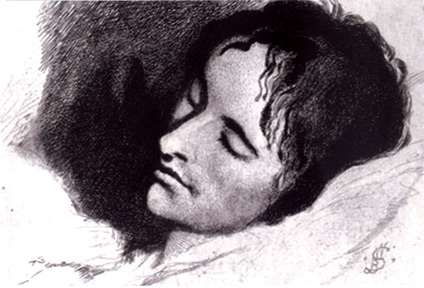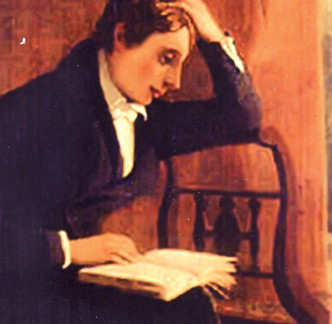|
John Keats's poetry :
Beautiful, brilliant but squeamish
by Gwen Heart
[Part 1 ]
John Keats’ Endymion, Lamia and Isabella stand out from the rest of
his creations. He was unmatched among the male Romantics who opted to
represent an erotic feel with a female as a visionary experience. Many
men go through this experience when a woman they desire is unattainable.
But where Keats was concerned, it was different owing to his feminine
character that dominated his poetry.
|

Doctors’ mistakes were Keats's agonising end. |
Sad to say, his brilliance was one-sided, more feminine-connected. It
revealed his weak personality that prevented or clashed with the beauty
of words that made his poetry to scale dizzy heights.
A striking feat towards the discourse of Keats both in the 19th and
20th centuries is the frequency with which his gender was an issue not
on a matter of biology but his ideology in this context. A profound
division of judgement that he agitated was of interest not only to his
colleagues but the critics of his time who lost no time surfacing his
effeminate character in the language he used.
Many were to question or provoke this type of obsessive vocabulary in
his letters about the character differences and poetic existence.
However, Keats did not fit conventional theory that made him a
convenience focus for ideology.
He had his own literary style and sensibility which was the signature
that made him highly accessible to social and psychological influences.
Criticism
Byron was the first poet to come out openly and criticise Keats's
feminist bearing and together with John Lockhart forced a rhetoric that
puerilised to exclude Keats from adult male company from a serious
consideration as a poet.
They tabbed him as one from the Cockney School. Though it hurt Keat's
ego, he was aware that he was born in the city of London. ‘Cockney’
implies being a mother's darling, a child brought up tenderly.
All poets of his generation found Keats spoilt by Cockneyfying but
Byron was different and thought Keats was spoilt by sexual immaturity.
But Keats had his own charm that drew women to him with elegance. This
made it worse as he plunged into their admiration and affection that
unwittingly ended up in his poems. He was never the spirited man women
thought him to be.
But no poet attracted so many literary biographers as Keats among
Romantic poets. He blazed a trail full of then and new readers will find
Keat's aura especially in poetry of Keats by Brian Stone in the Penguin
series published in 1992. All writers have criss-crossed his poems and
keep rediscovering his amazing virtuosity. Keats was a consistent
writer. Criticism has been more traditional with literary scope and
method. In recent times critics tend to concentrate on matters of style
and artistic purpose.
There is always a story or a legend in his long poems. A fine example
is Isabella, a stunning story that lifted the imagination of composers.
One of them was the story in musical lyrics at the spacious ornate
auditorium of the Royal Albert Hall with the BBC Orchestra conducted by
Sir Harrison Birtwistle. The original score was by Franck Bridge
(179-1941) in Concerto for Violin and Orchestra 25 and it was such a
marvellous hypnotic performance, I still feel it ringing in my ears. A
wide full orchestra three times over with so many harps, may have been
around 100 musicians that I had never seen even with the London
Philharmonic Orchestra. It was so amazing and such a wonderful tribute
to Keyts's Isabella. Sir Harrison being one of the magnificent
conductors of the day, rose in full stature bringing so many violins to
the fore. It was really a string affair presented by the BBC Symphony
Orchestra.
|

John Keats |
‘In poetry, his was the woman's part’ was the comment of a woman
critic on Keats.
Effeminacy
Inspite of many writings on Keats into the feminine sphere throughout
the century, he displayed such effeminacy of mind in The Eve of St.
Agnes and described a dress with more gust and beauty so much so that it
condescended appreciatively to Keats's poems to be marketed for female
audiences.
A critic described it as mere entertainment for women. Charles Brown
prefaced his biographical sketch which image Keats's absorption into
feminine afterlife. It eulogised Keats's genius as delicate and fragile
than it was beautiful.
Perhaps, he died on the promise that took root in hostile as well as
on fertile soil. It indicated a sensibility lacking sufficient masculine
vigour and resilience to bear the insulting arrows slung at him. Byron
was incredulous when he learnt from Shelly that the young Keats died in
Rome bursting a blood vessel and in despair and anguish at the
contemptuous attack on his book in the Quarterly.
‘I did not think that criticism could be killing in a world of
bustle, especially in the career of writing! Byron was sad but had no
remorse for him. The image of Keats helped draw into orbit of a cultural
preoccupation of the widely circulated reports that dominated the 19th
century. The efforts to secure distinctions between the genders and
stabilise the conduct was liable to sudden excesses but Keats may have
not been aware when it was taking a toll on his life and works that
resulted in death.
‘Roseates and pained as a ravish'd nymph
into a hue more roseate than sweet pain,
Gives to a ravish'd Nymph when her warm tears Gush lucsious with no
snob’
To be continued |

